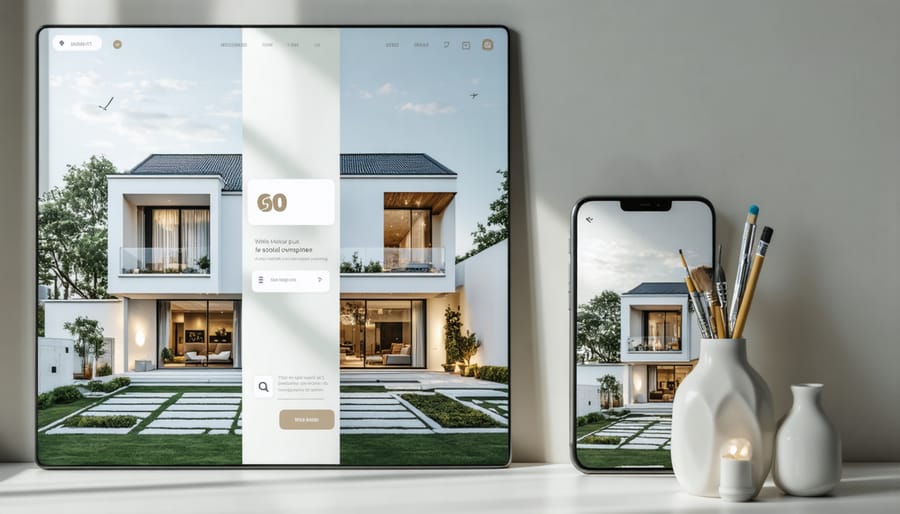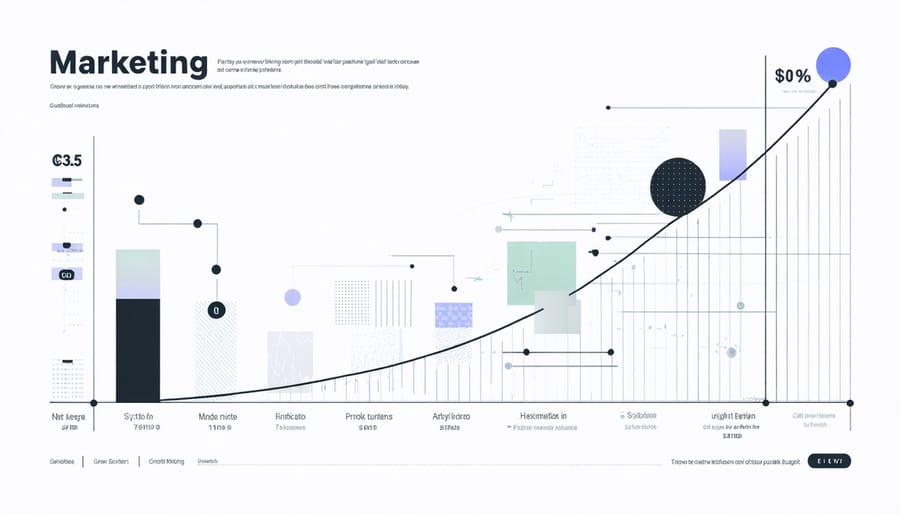Transform your real estate business with a strategic 12-month marketing roadmap that eliminates guesswork and maximizes ROI. Launch targeted digital marketing strategies each quarter, track measurable outcomes, and adapt tactics based on market response. Modern real estate success demands more than sporadic social media posts or occasional email blasts—it requires a synchronized, data-driven approach that builds momentum throughout the year.
Whether you’re a seasoned agent or breaking into the market, a well-structured annual marketing plan serves as your roadmap to consistent lead generation, brand building, and client retention. This comprehensive guide breaks down essential monthly activities, budget allocation strategies, and cutting-edge marketing techniques specifically designed for today’s real estate landscape. From leveraging seasonal market trends to implementing automated lead nurturing systems, discover how to create a sustainable marketing ecosystem that delivers results month after month.
Q1: Building Your Digital Foundation (January-March)
January: Digital Audit and Goal Setting
Start your year strong by conducting a comprehensive digital audit of your real estate marketing presence. Begin with a thorough assessment of your website’s performance, analyzing key metrics like page load speed, mobile responsiveness, and user engagement. Tools like Google Analytics can reveal valuable insights about your visitor behavior and conversion rates.
Next, evaluate your social media footprint across all platforms. Review your engagement rates, follower growth, and content performance on Instagram, Facebook, LinkedIn, and other relevant channels. Consider implementing AI-powered marketing tools to streamline your social media management and enhance content creation.
Set SMART (Specific, Measurable, Achievable, Relevant, Time-bound) marketing objectives for the year ahead. Examples include:
– Increasing website traffic by 30%
– Growing your email list by 500 subscribers
– Achieving a 15% higher engagement rate on social media
– Generating 25% more qualified leads
Document these goals and create a tracking system to monitor your progress throughout the year. Remember to establish baseline metrics during your audit to effectively measure improvements and adjust strategies as needed.

February: Content Strategy Development
February marks the perfect time to develop a robust content strategy that will fuel your real estate marketing efforts throughout the year. Start by creating detailed buyer personas that represent your ideal clients, whether they’re first-time homebuyers, luxury property investors, or empty nesters looking to downsize.
Develop a comprehensive content calendar that outlines topics, formats, and publishing schedules. Plan for a mix of content types including market analysis reports, property showcase videos, neighborhood guides, and homebuying tips. Consider seasonal trends and local events that might influence your content – such as spring buying season or local festivals that attract newcomers to your area.
Identify your primary distribution channels and tailor content accordingly. Instagram might feature stunning property photos and virtual tours, while LinkedIn could showcase market insights and industry expertise. Don’t forget to plan email newsletter content that nurtures leads throughout their buying journey.
Create content clusters around key themes like “local market insights,” “home maintenance tips,” and “investment strategies.” This approach helps establish your authority while improving SEO performance. Remember to incorporate both evergreen content that remains relevant year-round and timely pieces that address current market conditions.
Set measurable goals for each content piece and establish tracking mechanisms to monitor performance. This data will help refine your strategy as the year progresses.
March: SEO and Local Search Optimization
As the spring market heats up, it’s crucial to optimize your online presence through effective SEO and local search strategies. Start by conducting a comprehensive audit of your website’s current SEO performance, focusing on real estate-specific keywords and local search terms.
Create location-specific landing pages for each neighborhood you serve, incorporating relevant keywords naturally into your content. Ensure your Google Business Profile is fully optimized with accurate business information, high-quality photos, and regular updates about your listings and services. While implementing these changes, always follow digital security best practices to protect your online assets.
Focus on building local citations across real estate directories and ensure NAP (Name, Address, Phone) consistency across all platforms. Implement schema markup on your website to help search engines better understand your content and improve your local search visibility.
Generate neighborhood-specific content, including market reports, community guides, and local event calendars. Encourage satisfied clients to leave reviews on your Google Business Profile and other relevant platforms. Remember to respond promptly and professionally to all reviews, both positive and negative, to demonstrate your commitment to client satisfaction and boost your local search rankings.
Q2: Engagement and Lead Generation (April-June)

April: Social Media Campaign Launch
As spring brings renewed interest in real estate, April is the perfect time to launch a comprehensive social media campaign. Start by auditing and optimizing your profiles across Instagram, Facebook, LinkedIn, and Twitter to ensure brand consistency. Create a content calendar that includes three key post types: property showcases, market insights, and personal branding content.
For Instagram, focus on high-quality property photos and virtual tour snippets, using Instagram Stories for behind-the-scenes glimpses of property viewings. Implement location-specific hashtags and engage with local community accounts to boost visibility. On Facebook, leverage the platform’s robust targeting options to run sponsored posts featuring your premium listings, targeting specific demographics and neighborhoods.
LinkedIn calls for a more professional approach – share market analysis, industry insights, and success stories. Create weekly carousel posts highlighting local market trends and investment opportunities. For Twitter, focus on real-time updates, including new listings, open house announcements, and quick market snapshots.
Enhance engagement by responding to comments within two hours, hosting weekly live sessions on Instagram or Facebook, and implementing interactive elements like polls and Q&A sessions. Track metrics such as engagement rates, reach, and lead generation to optimize your strategy throughout the month.
May: Email Marketing Setup
Email marketing remains one of the most effective digital products for real estate professionals, offering an impressive ROI when done right. This month, focus on building a robust email marketing foundation that will serve you throughout the year.
Start by segmenting your contact list into distinct categories: potential buyers, recent inquiries, past clients, and property investors. Create targeted lead magnets like neighborhood guides, market reports, or first-time homebuyer checklists to grow these lists organically.
Set up automated welcome sequences for new subscribers, introducing them to your services and establishing your expertise. Design at least three nurture campaigns:
– Market Updates (monthly newsletter)
– Buyer’s Journey (educational series)
– Investment Opportunities (exclusive listings)
Use email automation tools to schedule regular touchpoints, ensuring consistent communication without overwhelming your audience. Track key metrics like open rates and click-through rates to refine your approach. Remember to include clear calls-to-action in every email, whether it’s booking a consultation or viewing new listings.
Pro tip: Personalize your emails beyond just using the recipient’s name. Include relevant property recommendations based on their search history or previous interactions.
June: Paid Advertising Implementation
As the summer market heats up, June is the perfect time to launch and optimize your paid advertising campaigns. Start by allocating your advertising budget across multiple platforms, with a primary focus on Facebook Ads, Google Ads, and Instagram Ads. Create targeted campaigns that showcase your listings using high-quality images and compelling copy.
Set up separate ad groups for different audience segments: first-time homebuyers, luxury property seekers, and property investors. Implement retargeting campaigns to reach users who’ve previously visited your website or engaged with your content. For Google Ads, focus on local keywords and neighborhood-specific terms that potential buyers are searching for.
Monitor your key performance indicators (KPIs) daily, including click-through rates, cost per lead, and conversion rates. A/B test different ad creatives, headlines, and calls-to-action to optimize performance. Consider implementing dynamic ads that automatically pull in your latest listings and adjust your bidding strategy based on peak browsing times.
Don’t forget to create custom landing pages for each campaign to ensure message consistency and improve conversion rates. Set up proper tracking with Google Analytics to measure the effectiveness of each channel and adjust your budget allocation accordingly. Remember to comply with all real estate advertising regulations while maintaining a competitive edge in your market.
Q3: Content Marketing Acceleration (July-September)
July: Video Marketing Integration
As video content continues to dominate social media and digital marketing, July is the perfect time to enhance your property listings with compelling video content. Start by creating high-quality property walkthrough videos that showcase each home’s unique features and selling points. Invest in a good-quality smartphone gimbal or stabilizer to ensure smooth, professional-looking footage.
Develop a consistent video content calendar that includes virtual tours, neighborhood highlights, and market update videos. Share these across multiple platforms, including YouTube, Instagram Reels, and Facebook. Consider creating short, engaging clips for TikTok to reach younger homebuyers.
Incorporate drone footage when possible to capture aerial views of properties and neighborhoods, providing potential buyers with a comprehensive perspective. Create educational content such as “Home Buying Tips” or “Market Trend Analysis” videos to establish yourself as an industry expert.
Remember to optimize your videos with relevant titles, descriptions, and tags for better search visibility. Include clear calls-to-action and contact information in every video description. Track engagement metrics to understand which types of video content resonate most with your audience, and adjust your strategy accordingly.
Use customer testimonials and success stories in video format to build trust and credibility with potential clients. These authentic experiences can be powerful marketing tools that showcase your expertise and commitment to client satisfaction.

August: Blog Content Scaling
August marks the perfect time to scale your blog content strategy, transforming your real estate website into a valuable resource hub. Start by conducting keyword research focused on seasonal topics like “back-to-school home buying” and “end-of-summer market trends.” Create a content calendar that includes both evergreen topics and timely market updates.
Implement a mix of content types, including market analysis pieces, neighborhood guides, home maintenance tips, and buyer/seller advice. Aim to publish at least 2-3 high-quality posts per week, ensuring each piece provides actionable insights for your audience. Consider developing content clusters around popular themes like “first-time homebuying” or “investment properties” to boost your SEO effectiveness.
To maximize impact, incorporate rich media elements such as infographics, local market statistics, and professional photography. Establish a consistent posting schedule and promote each piece across your social media channels. Don’t forget to optimize each post with relevant meta descriptions, alt tags, and internal links to related content on your site.
Consider collaborating with local experts for guest posts, adding credibility to your blog while expanding your reach. Track engagement metrics to refine your content strategy and identify which topics resonate most with your audience.
September: Virtual Tours and Interactive Content
As the real estate market continues to embrace digital innovation, September is the perfect time to upgrade your property presentations with virtual showing technologies and interactive content. Start by investing in high-quality 3D virtual tours that allow potential buyers to explore properties at their convenience. These immersive experiences have become increasingly important, with many buyers making purchase decisions based on virtual viewings alone.
Enhance your virtual tours with interactive hotspots that highlight key features like updated appliances, custom finishes, or smart home technologies. Consider implementing virtual staging options to help buyers visualize different furniture arrangements and design possibilities. Don’t forget to add detailed floor plans and measurement tools that enable precise space planning.
To maximize engagement, integrate these virtual experiences across your marketing channels. Share snippets on social media, embed tours in your email campaigns, and feature them prominently on your website. Track viewer engagement metrics to understand which property features attract the most attention and adjust your presentation accordingly.
Remember to create mobile-friendly versions of your virtual content, as many buyers browse properties on their smartphones. Consider offering live virtual open houses with real-time Q&A sessions to maintain the personal touch that’s essential in real estate transactions.
Q4: Analytics and Optimization (October-December)

October: Performance Analysis
As the year enters its final quarter, October is the perfect time to conduct a thorough performance analysis of your real estate marketing efforts. Start by gathering data from all your marketing channels, including social media engagement rates, website traffic, lead generation numbers, and conversion rates. Pay special attention to metrics that directly impact your bottom line, such as cost per lead and return on marketing investment (ROMI).
Create a comprehensive spreadsheet tracking which campaigns yielded the highest engagement and conversion rates. Identify patterns in successful listings, such as specific photography styles, property description formats, or posting times that generated more interest. Review your email marketing metrics, focusing on open rates and click-through rates to determine which content resonates most with your audience.
Don’t forget to analyze your social media presence across platforms. Which types of posts earned the most shares and comments? What kind of content drove the most qualified leads? Use these insights to refine your strategy for the remaining months and begin planning for the upcoming year.
Survey your clients and team members for qualitative feedback about your marketing efforts. This combination of hard data and personal insights will help you make informed decisions about resource allocation and strategy adjustments for the future.
November: Strategy Refinement
As the year draws to a close, November is the perfect time to analyze your marketing performance data and make strategic adjustments for the upcoming year. Begin by reviewing key metrics from your various marketing channels, including social media engagement rates, email open rates, website traffic, and lead conversion statistics. Pay special attention to which property listings generated the most interest and which marketing tactics delivered the highest ROI.
Use this data to identify trends and patterns in buyer behavior and market response. Are virtual tours generating more leads than traditional photo galleries? Which social media platforms are driving the most qualified traffic? Document these insights to inform your strategy for the coming year.
This is also the time to assess your budget allocation across different marketing channels. Consider scaling up investment in high-performing areas while either optimizing or phasing out underperforming initiatives. Don’t forget to gather feedback from your team and clients about what worked well and what could be improved.
Finally, start drafting preliminary marketing plans for the new year, incorporating lessons learned and emerging real estate marketing trends. This proactive approach ensures you’ll hit the ground running in January.
December: Next Year Planning
December is the perfect time to evaluate your current year’s performance and lay the groundwork for an even more successful year ahead. Start by analyzing your key performance indicators (KPIs) from the past year, including lead generation rates, conversion metrics, and ROI from various marketing channels. This data will help inform your strategy moving forward.
Create SMART goals for the upcoming year – Specific, Measurable, Achievable, Relevant, and Time-bound. Consider both short-term objectives (quarterly targets) and long-term aspirations. Focus on areas like market share growth, lead quality improvement, and digital presence enhancement.
Develop a comprehensive budget allocation plan for your marketing initiatives. Review which channels delivered the best results this year and adjust spending accordingly. Don’t forget to set aside resources for emerging technologies and platforms that could benefit your real estate business.
Build a detailed content calendar for the first quarter, including social media posts, blog topics, and email marketing campaigns. This gives you a running start in January. Also, plan your major marketing campaigns and events for the entire year, ensuring you have adequate preparation time for each.
Finally, schedule regular check-ins throughout the coming year to monitor progress and make necessary adjustments to your strategy.
A well-executed 12-month real estate marketing plan can transform your business from sporadic success to consistent growth. Throughout this comprehensive guide, we’ve explored the essential components of a year-long marketing strategy that combines traditional methods with digital innovations to create a powerful presence in your local market.
Remember that success in real estate marketing isn’t about implementing everything at once. It’s about steady, strategic progress and consistent effort throughout the year. The quarterly breakdown we’ve discussed allows you to focus on specific goals while building upon previous achievements, creating a sustainable and scalable marketing approach.
Key to your success will be the regular monitoring and adjustment of your strategies. Track your metrics monthly, analyze what’s working, and be prepared to pivot when necessary. Whether it’s your social media engagement, email open rates, or website traffic, data-driven decisions will help optimize your marketing efforts.
Don’t forget the importance of maintaining a balanced approach. While digital marketing is crucial in today’s landscape, traditional networking and relationship-building remain fundamental to real estate success. Your marketing plan should seamlessly integrate both aspects to maximize your reach and impact.
As you implement this plan, remember that consistency is more important than perfection. Start with the strategies that align best with your current capabilities and gradually expand your efforts as you become more comfortable with each element.
Most importantly, treat this marketing plan as a living document. The real estate market is dynamic, and new marketing opportunities emerge regularly. Stay informed about industry trends, be willing to adapt, and always keep your target audience’s needs at the forefront of your strategy.
By following this structured approach and remaining committed to your marketing goals, you’ll be well-positioned to build a strong brand presence, generate quality leads, and achieve sustainable growth in your real estate business throughout the year and beyond.